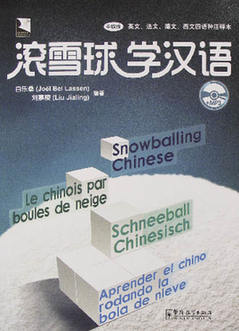Snowballing Chinese
Snowballing Chinese
By staff reporter LIU YI
 |
Snowballing Chinese By Joël Bel Lassen & Liu Jialing 128 pages RMB 48 Published in Beijing by Sinolingua in 2009 |
During his 30 years of teaching Chinese, Joël Bel Lassen found his students were more likely than not to figure out the meaning of every single character by themselves. Some were creative enough to go beyond dictionaries to employ their imagination. For example, the character for “greed,” from top to bottom, is 婪, made up of “wood” and “woman.” Students hypothesized it indicated Eve of the Garden of Eden. The particular approach to each character is obviously influenced by the mother tongue of the student and their cultural narratives. However, that’s indeed the way European students learned written Chinese.
Joël Bel Lassen is Inspector General for Chinese Language Teaching at the Ministry of Education in France, and an educator who believes teaching Chinese as a second language should focus on characters as a pedagogical unit, and not only on discrete words. Characters will snowball into compound words and expressions, and then sentences and articles. Natural curiosity, he feels, is what inspires students to explore and master the territory of this ancient language. That is the thesis of his new book, Snowballing Chinese.
Designed for those at elementary level, the textbook focuses on 900 characters – the minimum essential to basic literacy. Joël Bel Lassen applied his methods in every lesson, and also to the entire structure of his textbook. In each lesson, students read a text of 100 to 200 characters – a reasonable length so as to simplify and encourage greater oral expression. For some puzzling words, students can refer to the Vocabulary section (Chinese-English, French, German, Spanish). In the Extension section, students can look up the explanation, usage and new compounds made up of characters previously learned. The Exercises in the last part include open questions and composition. Students are required to use new words repeatedly, and develop skills in logical construction and writing.
Snowballing’s pedagogy is not fresh; scientists have already found that toddlers, after learning 50 words, would experience an explosion of language use. They seem to grasp a great number of words overnight, which is a typical snowballing effect. But as Lassen has applied this science to structured teaching, words and expressions used frequently reoccur in many contexts, so learners commit them to memory more efficiently and employ them more frequently.
In 1973 when China and France resumed cultural exchanges, 23-year-old Bel Lassen, who had just graduated as a Chinese major, was selected to be among the first group of government-funded students sent to China. He studied in Beijing Language and Culture University and later Peking University. However, there were some taboos for a foreigner in the rather conservative society of that time. For example, he couldn’t talk to Chinese students for a long time or share the same dormitory. An accident left him with a back injury that confined him to hospital for a period of time, but brought an unexpected opportunity his way. “I made dramatic progress in Chinese as I communicated with the doctors, nurses, ward mates and cooks that worked there.” He then immersed himself in social activities – working in iron foundry and laboring alongside local farmers. His two-year stay deepened his comprehension of the language in conditions rarely available to others, and also gave him an understanding of the life and culture of the Chinese people.
In Snowballing Chinese, written in collaboration with Liu Jialing, the Sinologist has recreated a similar situation for Western students. Wang Jing, a European youth, is the hero of the book. He likes traveling, philosophizing, and has broad interests. The texts tell students about his life and work, what he saw on the way home, and what he thought when watching news. “Teaching Chinese requires not only linguistic knowledge but also communication skills,” said Joël Bel Lassen. “We should create for our students conditions that help them learn it easily and happily.”
Joël Bel Lassen hopes the book will help students achieve competency at a greater rate. The 900 characters are no more indecipherable scratchings but symbols inter-connected by stories. Classroom use has in fact yielded positive feedback, and students have measurably increased their Chinese language ability, specifically through enlarged vocabulary, consolidated grammatical knowledge, and better skill and clarity at expressing their ideas and opinions.
When Snowballing Chinese first came out at the Frankfort Book Fair in October 2009, it attracted wide attention from publishers and distributors. One of the biggest French distributors – Sceren – intends to promote Snowballing Chinese in the European market. The first edition went on display at the Expo-langues of Paris in February 2010.
Services
Economy
- Eco-agriculture and Eco-tourism Power Nanchang’s Green Development
- Balance Environmental Protection and Economic Prosperity – Nanchang Looks to European Technology for Green Development
- Sustainable Growth Requires Wiser Energy Use
- Chinese Economy: On the Path of Scientific Development
- China's Economy over the Last Ten Years

